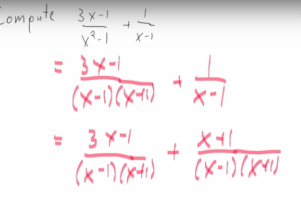
It took me longer than I'm comfortable admitting to understand how it works simplifying x^2 - 1 into (x - 1)(x + 1), (does that only work when the constant is a 1 or negative one?) and I'm immediately stuck on something else!
As I understand it, the entirety of (x - 1)(x +1) is the denominator, so wouldn't all that multiply by the numerator and denominator of 1/(x - 1) resulting in (x - 1)(x +1)/(x - 1)(x +1)(x - 1)?
And, following the formula for adding fractions that preceded this part of the video, the x - 1 denominator should multiply across to the numerator of the other fraction, so the end result would be something like [(3x-1)(x-1)+(x - 1)(x +1)] / (x-1)(x+1)(x-1)
This is obviously not what he'd doing, what information/knowledge am I missing or misunderstanding?
